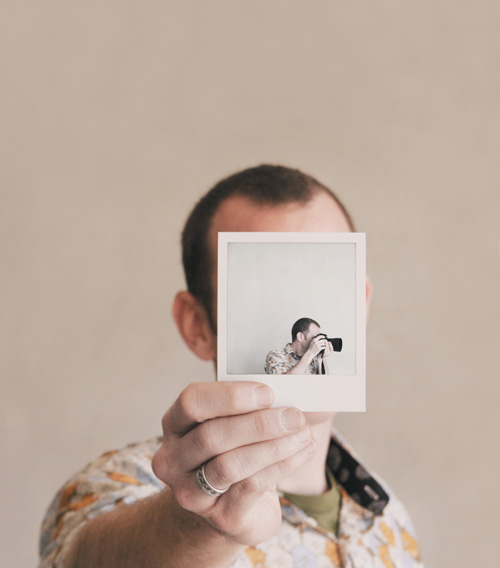10. Turn Your Camera Around

Some pictures are taken while others are made. Self-portraits by their very nature are pictures that require thinking, planning, and preparation. It’s the setup and process that lead to making a picture that reveals.
Canon 5DMii, 50mm lens, f/2
BECOMING A MORE THOUGHTFUL and engaged photographer requires that we reflect upon, and seek to understand, who we are and who we want to become. It is easy to skim the surface of our story and disregard the details of our life as banal and bland. Yet your own story is one of a kind and worth exploring more.
We have to grind and mill the contents of our life to be able to tell better photographic stories. Each life story is made up of tragedies, blessings, anxiety, peace, loss, love, dreams, devastation, joy, and more. By tapping into the entirety of our lives we can tell a fuller story with photographs. One way to experience the harvest of this labor is to create a story-filled self-portrait.
Tell Your Story
As humans, we are fascinated by our own likeness, whether for curiosity, vanity, or self-reflection. Seeing ourselves in visual form raises the questions of age, identity, and the core of self. Some, like Narcissus or Lady Gaga, have been caught up and tangled in the pursuit of these questions. Others, like Socrates, found higher ground by following the statement, “An unexamined life is not worth living.” That is the tack or the goal of this exercise: Create a series of self-portraits that conveys and clarifies who you are.

My grandfather was an artist with a vibrant zeal for life, but he died before I was born. His creative spirit lives on. Using a self timer, I captured this portrait of me holding the only item of his I own—his camera.
Canon 20D, 50mm lens, f/4
Exercise: Self-Portrait
Photographing people is a heightened experience that momentarily allows you to forget about yourself and to focus on another. Photography liberates you to tell another person’s story. But such focus causes us to forget what it is like to be on the other side of the lens. By turning the camera around and creating self-portraits, this exercise will help you develop as an artist as you dig into your life.
The goal is to create a series of self-portraits that helps you examine your life and depict a portion of your life story. Aim to create portraits that aren’t just visually interesting but have something to say.
Step 1 Reflection Self-Portrait
Photograph yourself in any type of a reflective surface—mirror, water, or the side of a shiny black car. Try to find a surface that allows you to include a few telling personal details. For some ideas and inspiration do an online search for Vivian Maier self-portraits.
Tips
Take time to think about the pictures that you will make. Self-portraiture can be trite or profound—it depends upon you.
While self-portraiture can be uncomfortable, commit to the process as a chance to learn something new.
Self-portraits help us discover and grow, but they are not made only for the photographer. The best self-portraits can be a revelation or a simple gift for those that you know.
Shoot pictures that are up close and far away. Orient the camera in vertical and horizontal positions.
When taking the pictures, think about what you must look like from the subject’s point of view when you are capturing her. You’ll notice that the camera blocks much of your face, making it difficult to connect.
Continue shooting until you have ten good photographs.
Step 2 Outdoors Self-Portrait
Using the self-timer on your camera and without a tripod, create a well-composed photograph of yourself out in the world.
Experiment by placing your camera in different locations. Try to place it on a rock, hanging in a tree, or on the ground pointed up.
Most importantly, get outside and create a portrait in a setting that you have never been pictured in before.
Strive to create five interesting photographs.
Step 3 Arm’s-Length Self-Portrait
Use wide (16–35mm focal length) or normal (50mm focal length) lenses, hold your camera at arm’s length, point it toward you, and fire away.
Try positioning the camera high and low. Think of this as a chance to study what type of looks you can create from different perspectives and at this close of a range.
Exercise Details
Goal: Create 30 self-portraits. Tools: Camera and 16–35mm or 50mm lens. Light: Natural and available light. Location: Indoors or outdoors. Theme: Honest and telling self-portrait. Duration: 60 minutes.
For even more creativity, try lowering your shutter speed to 1/30 of a second and spin in a circle so that you are sharp and in focus while the background blurs.
Take enough pictures until you have sufficiently experimented with this technique.
Step 4 Post–Photo Shoot Reflections
After the photo shoot, take a few minutes to jot down what you learned from this experiment, both in being the subject and how you appear when you are shooting others.

ABOVE A self-portrait taken in a artist friend’s home. Together the decor and reflection make for an interesting frame.
Canon 5DMii, 50mm lens, f/2.8
OPPOSITE While I was setting up a camera, my daughter Annika, who was six years old, asked if she could take the picture herself. I loaded the film, focused the camera, and walked away. This picture wasn’t mine, but hers. Patiently, she stared into the lens and waited. Then she pushed the shutter release and created her first ever self-portrait. As a father, this image was a gift that makes my affection even more deep.
Wood large format 4 × 5, 90mm lens, f/5.6, Polaroid Type 72 Film
“Affection is responsible for nine-tenths of whatever solid and durable happiness there is in our lives.”
—C.S. Lewis

